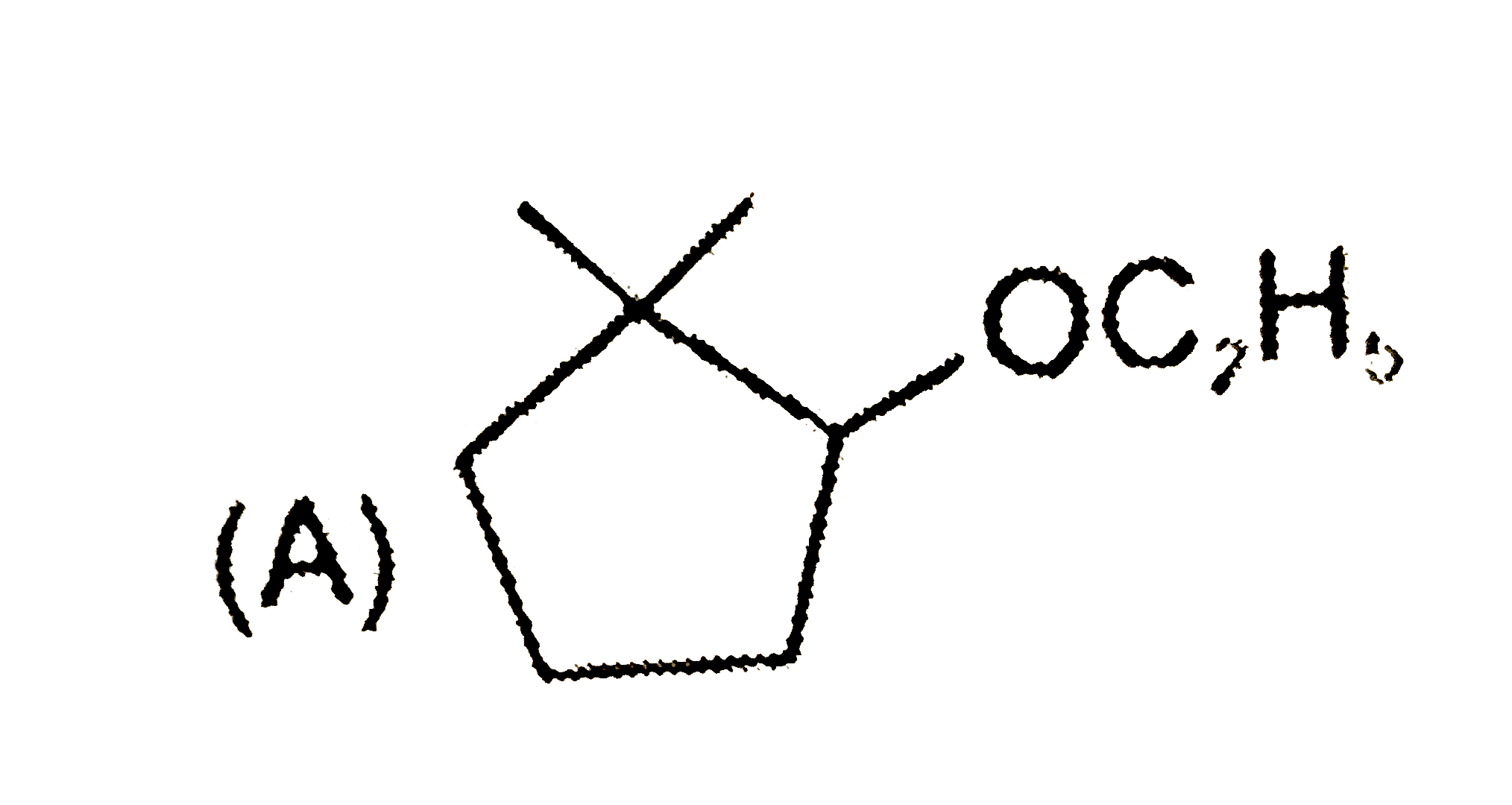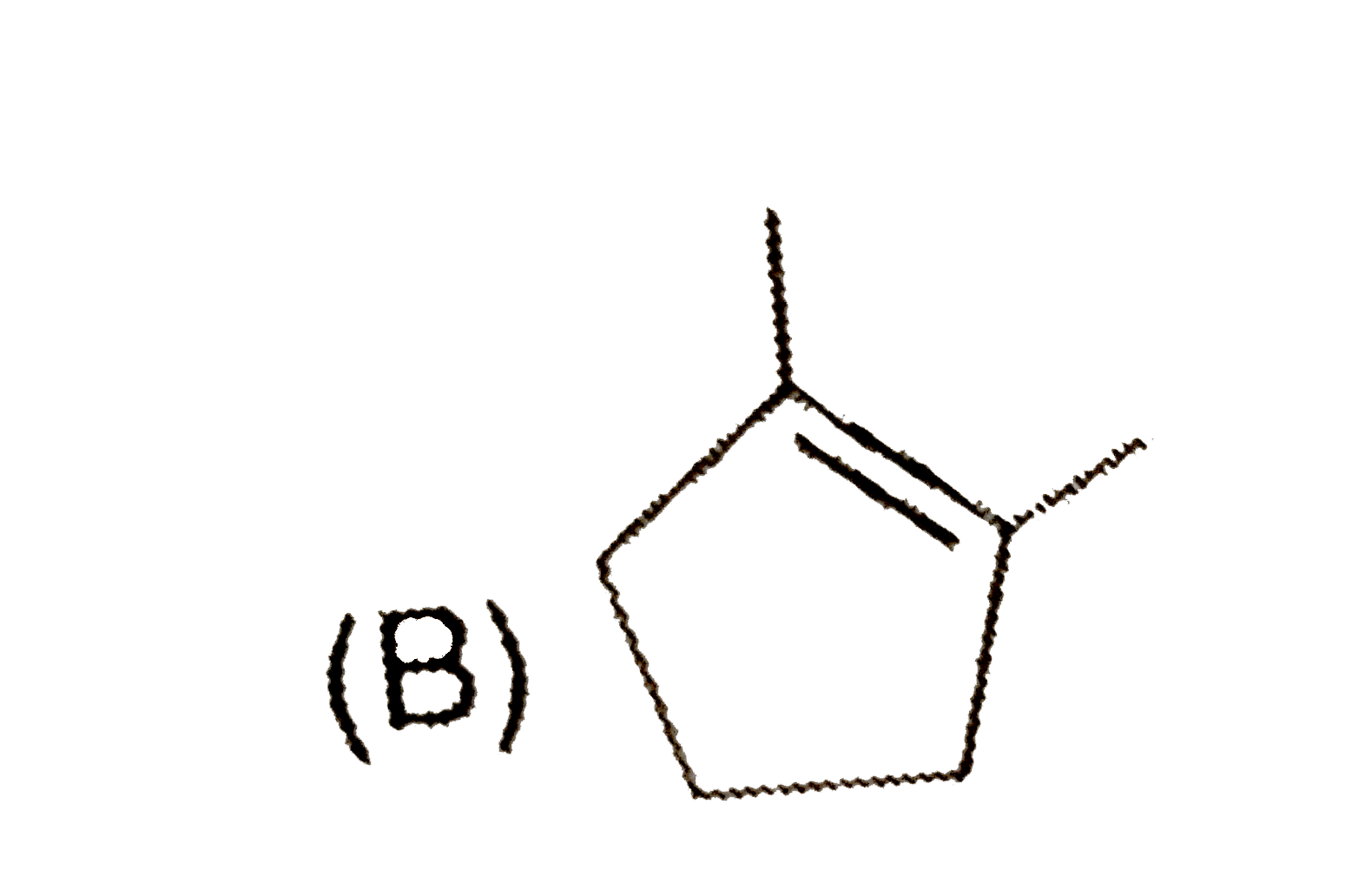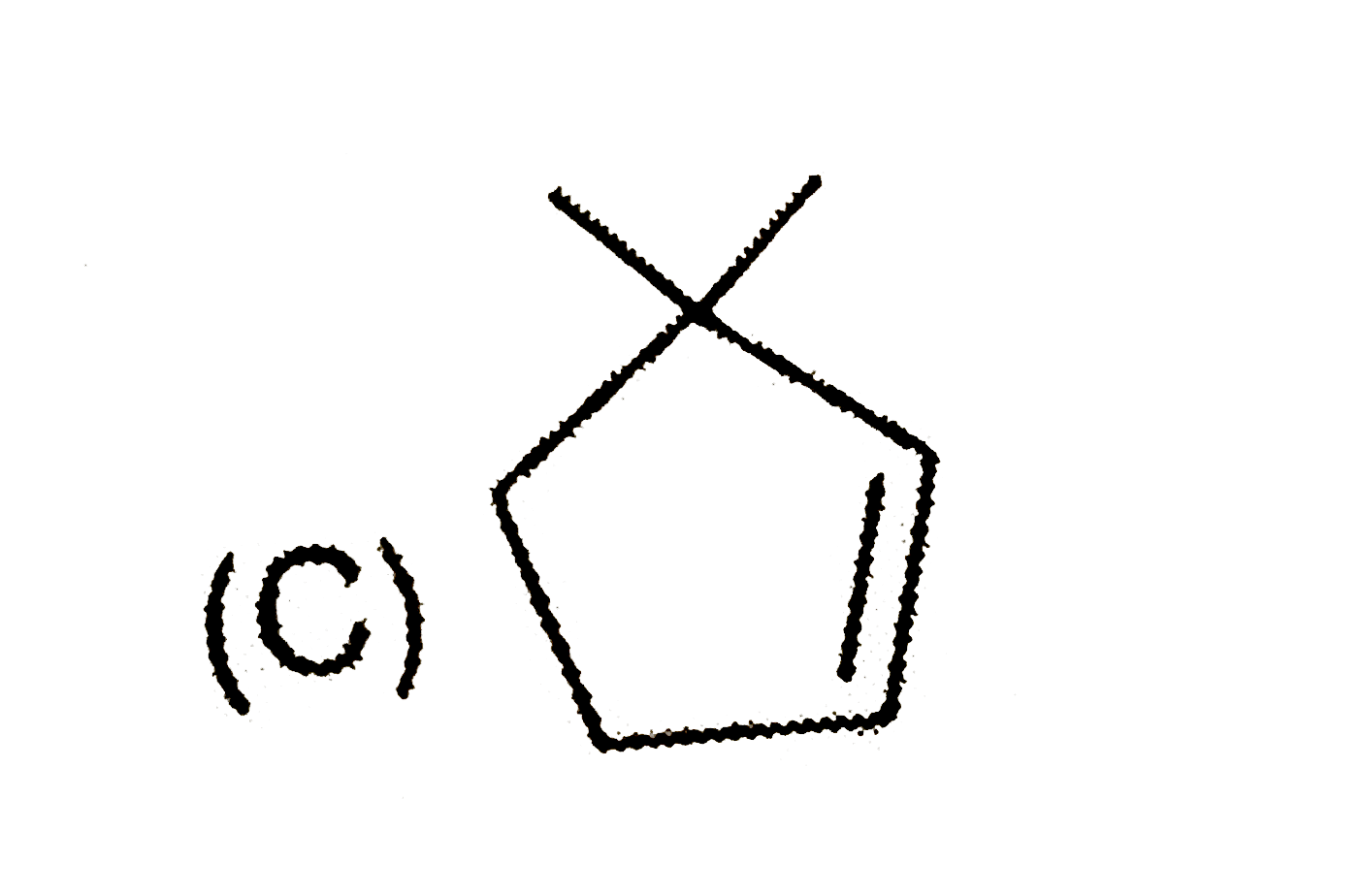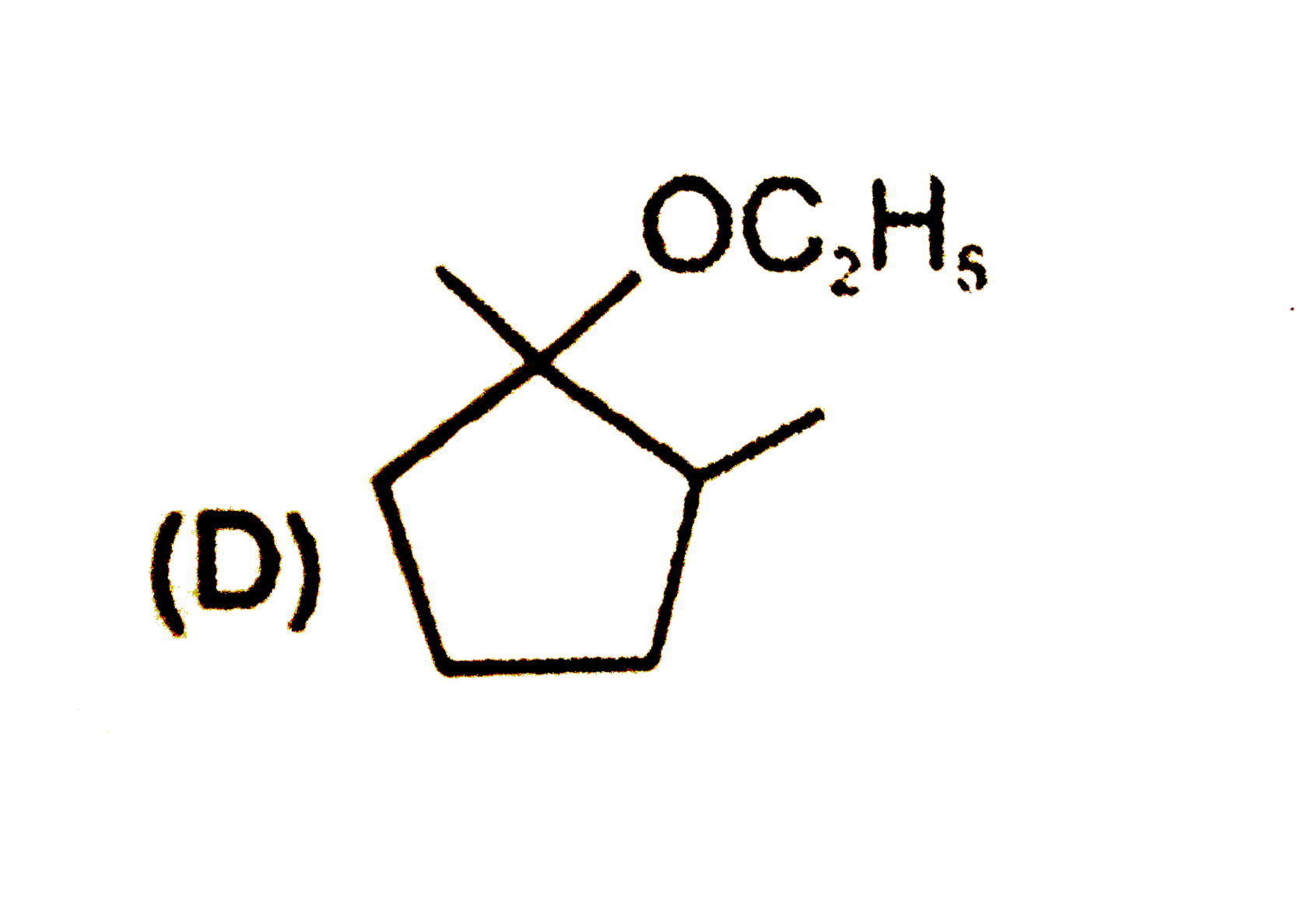Predict the products expected in the given reaction
2-Bromo-1,1-dimethylcycopentaneC2H5OH−−−−→Δ




The correct Answer is:A, B, C, D
To predict the products of the reaction between 2-bromo-1,1-dimethylcyclopentane and ethyl alcohol (C2H5OH) under heat, we can follow these steps:
Step 1: Identify the Reactant
The reactant is 2-bromo-1,1-dimethylcyclopentane. It is a secondary alkyl halide because the carbon attached to the bromine (Br) is connected to two other carbon atoms.
Step 2: Analyze the Conditions
The reaction is performed in the presence of ethyl alcohol (C2H5OH), which acts as a weak nucleophile. Additionally, heat is applied to the reaction mixture.
Step 3: Determine the Mechanism
Given that we have a secondary alkyl halide and a weak nucleophile, the reaction can proceed via either an SN1 or E1 mechanism. However, since heat is applied, it favors elimination reactions. Therefore, we can conclude that the E1 mechanism will take place.
Step 4: Formation of Carbocation
In the E1 mechanism, the first step involves the formation of a carbocation. The bromine atom (leaving group) departs, leading to the formation of a carbocation intermediate.
Step 5: Carbocation Rearrangement
The formed carbocation is a secondary carbocation. However, it can undergo rearrangement to form a more stable tertiary carbocation. In this case, one of the methyl groups can shift to stabilize the carbocation.
Step 6: Elimination of Proton
Once the more stable tertiary carbocation is formed, a proton (H+) is eliminated from an adjacent carbon atom. This results in the formation of a double bond.
Step 7: Final Product
The final product of this reaction will be an alkene. In this case, the product will be 1,1-dimethylcyclopentene.
Summary of the Reaction
The overall reaction can be summarized as follows:
2-bromo-1,1-dimethylcyclopentaneΔ,C2H5OH−−−−−−−→1,1-dimethylcyclopentene+HBr
The reactant is 2-bromo-1,1-dimethylcyclopentane. It is a secondary alkyl halide because the carbon attached to the bromine (Br) is connected to two other carbon atoms.
The reaction is performed in the presence of ethyl alcohol (C2H5OH), which acts as a weak nucleophile. Additionally, heat is applied to the reaction mixture.
Given that we have a secondary alkyl halide and a weak nucleophile, the reaction can proceed via either an SN1 or E1 mechanism. However, since heat is applied, it favors elimination reactions. Therefore, we can conclude that the E1 mechanism will take place.
In the E1 mechanism, the first step involves the formation of a carbocation. The bromine atom (leaving group) departs, leading to the formation of a carbocation intermediate.
The formed carbocation is a secondary carbocation. However, it can undergo rearrangement to form a more stable tertiary carbocation. In this case, one of the methyl groups can shift to stabilize the carbocation.
Once the more stable tertiary carbocation is formed, a proton (H+) is eliminated from an adjacent carbon atom. This results in the formation of a double bond.
The final product of this reaction will be an alkene. In this case, the product will be 1,1-dimethylcyclopentene.
The overall reaction can be summarized as follows:
2-bromo-1,1-dimethylcyclopentaneΔ,C2H5OH−−−−−−−→1,1-dimethylcyclopentene+HBr
Topper's Solved these Questions
- ORGANIC REACTION MECHANISMS-IVBOOK - RESONANCE ENGLISHCHAPTER - ORGANIC REACTION MECHANISMS-IVEXERCISE - Exercise-2 Part-4
8 Videos
- ORGANIC REACTION MECHANISMS-IVBOOK - RESONANCE ENGLISHCHAPTER - ORGANIC REACTION MECHANISMS-IVEXERCISE - Exercise-3 Part-1
18 Videos
- ORGANIC REACTION MECHANISMS-IVBOOK - RESONANCE ENGLISHCHAPTER - ORGANIC REACTION MECHANISMS-IVEXERCISE - Exercise-2 Part-2
7 Videos
- ORGANIC REACTION MECHANISMS - IIBOOK - RESONANCE ENGLISHCHAPTER - ORGANIC REACTION MECHANISMS - IIEXERCISE - APSP Part - 3
22 Videos
- PERIODIC TABLE & PERIODICITYBOOK - RESONANCE ENGLISHCHAPTER - PERIODIC TABLE & PERIODICITYEXERCISE - ORGANIC CHEMISTRY(BASIC CONCEPTS)
27 Videos
Similar Questions
Knowledge Check
In the given reaction [X] will be:
C6H5−C∣∣O−HNH2OH/H⊕−−−−−−−−→[X]Aonly syn oximeBonly anti aximeCmixture of syn and anti oximeDsecondary amide
Predict product(s) in the following reaction,
Cl2+OH−hot−−→?
View SolutionWrite the main product (s) in each of the following reaction :
(i) CH3−CH3∣C∣CH3−O−CH3+HI→
(ii) CH3−CH=CH2(i)B2H6−−−−−−−−−−−→(ii)3H2O2/OH−
(iii) C6H5−OH(i)aq.NaOH−−−−−−−−→(ii)CO2,H+
View SolutionWhat will be the final product in the following reaction sequence? CH3CH2CNH+/H2O−−−−−→ANH3−−→ΔBNaOBr−−−→C
View SolutionWhat would be the major products in the following reactions:
CH3−CH3∣C∣CH3−CH2BrC2H5OH−−−−→Δ
View SolutionWhat would be the major products in the following reactions:
CH3−CH3∣C∣CH3−CH2BrC2H5OH−−−−→Δ
View SolutionWhat would be the major products in the following reactions:
CH3−CH3∣C∣CH3−CH2BrC2H5OH−−−−→Δ
View SolutionIdentify the major product in the following reactions :
C6H5−CH2−H∣C∣Br−CH3Alc.KOH−−−−−→Δ?HBr−−→ ?
View Solution
